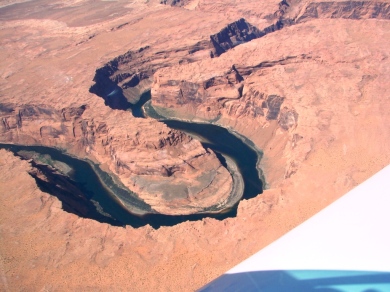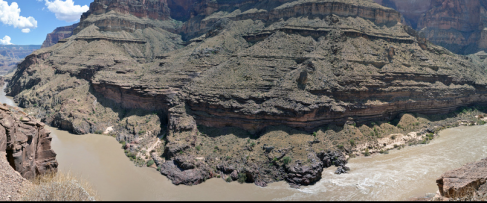Before Westminster decided to launch a campus in Mesa, all I knew about Arizona was that it was home to the Grand Canyon, one of the top destinations in my Bucket List. So last week, on my way to my new home in Mesa, I made a detour to spend three delightful days at the Canyon, and (along with only Venice in a life of blessed travel) it completely lived up to all of my expectations. Indeed, a blog entry on the Grand Canyon itself should consist of nothing but images and numbers, for the majesty, beauty, and history of the place defies description. I will, therefore, take a different track and post a few images (from Grand Canyon National Park’s flicker collection) with some impressions the Canyon can make on a business professor.
 Two sights take my breath away and make my heart skip several beats during an aerial tour of the Canyon. One is my first in-person glimpse of Horseshoe Bend, where the mighty Colorado executes a perfect U-turn and flows like an emerald ring around a giant’s finger, and the second is Glen Canyon Dam, where 400,000 buckets of concrete were masterfully arched across 1,560 feet and anchored safely to relatively weak rock, to regulate the Colorado’s flow.
Two sights take my breath away and make my heart skip several beats during an aerial tour of the Canyon. One is my first in-person glimpse of Horseshoe Bend, where the mighty Colorado executes a perfect U-turn and flows like an emerald ring around a giant’s finger, and the second is Glen Canyon Dam, where 400,000 buckets of concrete were masterfully arched across 1,560 feet and anchored safely to relatively weak rock, to regulate the Colorado’s flow.
 There is much debate these days centered around Man’s impact on the Earth, and the conversation is certainly welcome. These are large-scale issues of importance, of the sort that led Joubert to proclaim it “better to debate a question without settling it than to settle a question without debating it.” Yet folks tend to oversimplify, and it saddens me when we take our capacity to build structures like this dam – to channel the river around the site while it is built, to carve a two mile access tunnel starting on two sides of the east wall of the canyon and not be off more than a couple of inches where the two tunnels meet, to generate 4.5 billion kilowatt hours of electricity per annum – and present it as a threat, as a predilection to be deplored, instead of a magnificent gift to be continuously enhanced and carefully guided.
There is much debate these days centered around Man’s impact on the Earth, and the conversation is certainly welcome. These are large-scale issues of importance, of the sort that led Joubert to proclaim it “better to debate a question without settling it than to settle a question without debating it.” Yet folks tend to oversimplify, and it saddens me when we take our capacity to build structures like this dam – to channel the river around the site while it is built, to carve a two mile access tunnel starting on two sides of the east wall of the canyon and not be off more than a couple of inches where the two tunnels meet, to generate 4.5 billion kilowatt hours of electricity per annum – and present it as a threat, as a predilection to be deplored, instead of a magnificent gift to be continuously enhanced and carefully guided.
For America to stay competitive, for humanity to fulfill its potential, that type of thinking must be balanced, and it can most effectively be balanced by businessmen who unleash the power of scientists and engineers in ways that create value. We urgently need businessmen who can combine creativity with critical thinking, open mindedness with ethical decisions, analytical skills with wisdom, and who can collaborate with experts from every discipline. This is why I believe in business education, and liberal arts education. For eight years I’ve watched Westminster colleagues developing the sort of minds who can study the geology and the ecology and the human history of the Canyon, to design and manage and fund its projects, to create its public policies and multilingual multimedia documentaries.
 And yet, another growing debate of our age involves the value of college education. Since no one can question our goals, the argument must be with our processes. For three days, while I collect stories around the Canyon that seem relevant to a business curriculum – about Fred Harvey’s entrepreneurship, the tension between the tourism and mining industries, the birth of the FAA as a result of companies flying too low over the Canyon to treat their passengers to the great view, and even my personal reflections on the wisdom of investing in a rimside room where one will spend so little time in one’s hotel – a part of me keeps wrestling with my own big questions. How appropriate and how adequate are the pedagogical processes I have adopted? The stories to bring alive the scholarly theories, the realistic projects to foster skills, the connections to the broader liberal arts curriculum – do they add up to the managers I have sworn to develop? What am I missing?
And yet, another growing debate of our age involves the value of college education. Since no one can question our goals, the argument must be with our processes. For three days, while I collect stories around the Canyon that seem relevant to a business curriculum – about Fred Harvey’s entrepreneurship, the tension between the tourism and mining industries, the birth of the FAA as a result of companies flying too low over the Canyon to treat their passengers to the great view, and even my personal reflections on the wisdom of investing in a rimside room where one will spend so little time in one’s hotel – a part of me keeps wrestling with my own big questions. How appropriate and how adequate are the pedagogical processes I have adopted? The stories to bring alive the scholarly theories, the realistic projects to foster skills, the connections to the broader liberal arts curriculum – do they add up to the managers I have sworn to develop? What am I missing?
 My torment reaches its peak during a most enjoyable smooth water rafting trip. Our energetic young guide points out noteworthy bluffs and recent landslides and wild horses, and as enaging as he is, I can’t help playing a game of silent competition. That rock might look like a pirate, but this one over here looks like a griffin. This raven is no less interesting than that turkey vulture. And suddenly I am horrified by the thought that in the softer business classes – Fundamentals, Organizational Behavior, HR – our choice of the theories and cases and tools to include in our curriculum might be so random that we have no right to claim we are imparting valuable knowledge to our students. How can I say my students get more value out of my class (the guide’s narration) than simply getting a job (floating down the river) and making their own observations, perhaps creating their own tools and theories? What if the many smug self-made businessmen I’ve bantered with over the years are right and the only way to learn business administration is to skip the classroom and administer a business?
My torment reaches its peak during a most enjoyable smooth water rafting trip. Our energetic young guide points out noteworthy bluffs and recent landslides and wild horses, and as enaging as he is, I can’t help playing a game of silent competition. That rock might look like a pirate, but this one over here looks like a griffin. This raven is no less interesting than that turkey vulture. And suddenly I am horrified by the thought that in the softer business classes – Fundamentals, Organizational Behavior, HR – our choice of the theories and cases and tools to include in our curriculum might be so random that we have no right to claim we are imparting valuable knowledge to our students. How can I say my students get more value out of my class (the guide’s narration) than simply getting a job (floating down the river) and making their own observations, perhaps creating their own tools and theories? What if the many smug self-made businessmen I’ve bantered with over the years are right and the only way to learn business administration is to skip the classroom and administer a business?
 This inner tension is not new to me, nor will it be easily resolved. It does ease somewhat, though, when our guide maneuvers the boat so we can retrieve a plastic bottle from the river, and tells a story of a time he had to retrieve a half-drowned passenger. The captain, the lifeguard, the environmental steward – there are so many more ways in which this young man is our guide than in his narration, and thanks to him I got to survey parts of the river I could not see otherwise, even if he was pointing at pirates and vultures and I was seeing griffins and ravens. For a teacher, there is much food for thought in that.
This inner tension is not new to me, nor will it be easily resolved. It does ease somewhat, though, when our guide maneuvers the boat so we can retrieve a plastic bottle from the river, and tells a story of a time he had to retrieve a half-drowned passenger. The captain, the lifeguard, the environmental steward – there are so many more ways in which this young man is our guide than in his narration, and thanks to him I got to survey parts of the river I could not see otherwise, even if he was pointing at pirates and vultures and I was seeing griffins and ravens. For a teacher, there is much food for thought in that.